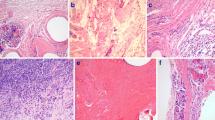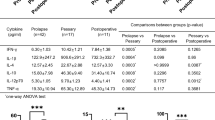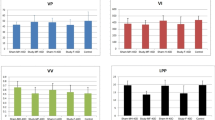Abstract
The aims were to determine whether bacteria-infection-elicited immune response after mid-urethral sling (MUS) may cause de novo urge symptoms (DNUS) and to evaluate the efficacy of suburethral sling excision for relieving the urgency. In a period of 40 months, 360 consecutive subjects with urodynamic stress incontinence had undergone one of three different MUS. Sixty-eight women with DNUS were included after exclusion. The suburethral sling of 24 of the 68 women needed to be excised because of refractory urgency. The excised vagina, or periurethral tissue, included sling of the study and control groups were sent for microbiological and immunohistochemical analyses. Statistically significant differences in the cell density percentage of CD68, CD25, CD4+CD25 and positive rate of Gram (+) bacteria were noted between two groups (p = 0.024, p = 0.053 and 0.016, respectively, p < 0.001). The success rate of sling excision was 80.2%. In conclusion, bacteria-infection-related immune hyperreactivity might explain the pathologic basis of DNUS after MUS.


Similar content being viewed by others
References
Ulmsten U, Petros P (1995) Intravaginal slingplasty (IVS): an ambulatory surgical procedure for treatment of female urinary incontinence. Scand J Urol Nephrol 29(1):75–82
Deval B, Je, ffry L, Najjar FA, Soriano D, Darai E (2002) Determinants of patient dissatisfaction after a tension-free vaginal tape procedure for urinary incontinence. J Urol 167(5):2093–2097
Falconer C, Ekman-Ordeberg G, Malmstrom A, Ulmsten U (1996) Clinical outcome and changes in connective tissue metabolism after intravaginal slingplasty in stress incontinent women. Int Urogynecol J 7(3):133–137
Abrams P, Cardozo L, Fall M, Griffiths D, Rosier P, Ulmsten U, Van Kerrebroeck P, Victor A, Wein A (2003) Standardisation Sub-Committee of the ICS. The standardisation of terminology in lower urinary tract function: report from the standardisation sub-committee of the ICS. Urology 61(1):37–49
Botros SM, Miller JJ, Goldberg RP, Gandhi S, Akl M, Beaumont JL, Sand PK (2007) DO and urge urinary incontinence following transobturator versus midurethral slings. Neurourol Urodynam 26:42–45
Goldsby RA, Kindt TJ, Osborne BA, Kuby J (2003) Immune response to infectious diseases. In: Immunology. W. H. Freeman and Company, New York, pp 389–412
Kaisho T, Takenchi O, Kawai T, Hoshino K, Akira S (2001) Endotoxin-induced maturation of MyD88-deficient dendritic cells. J Immunol 166:5688–5694
Wang AC, Chen MC (2003) Comparison of tension-free vaginal taping versus modified Burch colposuspension on urethral obstruction: a randomized controlled trial. Neurourol Urodyn 22:185–190
Dargent D, Bretones S, George P, Mellier G (2002) Insertion of a sub-urethral sling through the obturator membrane for treatment of female urinary incontinence. Gynecol Obstet Fertil 30(7–8):576–582
Plazk L, Staskin DR (2002) Midurethral slings work—but why? Quarterly newsletter on incontinence diagnosis, treatment and care Spring:4–8
Axelrod SL, Blaivas JG (1987) Bladder neck obstruction in women. J Urol 137(3):497–499
Wang AC, Lee LY, Lin CT, Chen JR (2004) A histologic and immunohistochemical analysis of defective vaginal healing after continence taping procedures: A prospective case-controlled pilot study. Am J Obstet Gynecol 191:1868–1874
Danese S, Sans M, Scaldaferri F, Sgambato A, Rutella S, Cittadini A, Pique JM, Panes J, Katz JA, Gasbarrini A, Fiocchi C (2006) TNF-alpha blockade down-regulates the CD40/CD40L pathway in the mucosal microcirculation: A novel anti-inflammatory mechanism of infliximab in Crohn's disease. J Immunol 176(4):2617–2624
Fux CA, Costerton JW, Stewart PS, Stoodley P (2005) Survival strategies of infectious biofilms. Trends Microbiol 13(1):34–40
Tang L, Eaton JW (1995) Inflammatory responses to biomaterials. Am J Clin Pathol 103:466–471
Deprest J, Zheng F, Konstantinovic M, Spelzini F, Claerhout F, Steensma A, Ozog Y, De Ridder D (2006) The biology behind fascial defects and the use of implants in pelvic organ prolapse repair. Int Urogyn J 17:S16–25 2006
Brubaker L (2004) Urgency: the cornerstone symptom of overactive bladder. Urology 4(6 Suppl 1):12–16
Lin CT, Chang TC, Shaw SW, Cheng PJ, Huang CT, Chao A, Soong YK, Lai CH (2006) Maintenance of CD8 effector T cells by CD4 helper T cells eradicates growing tumors and promotes long-term tumor immunity. Vaccine 24(37–39):6199–6207
Wood KJ, Sakaguchi S (2003) Regulatory T cells in transplantation tolerance. Nature Rev Immunol 3:199–210
Acknowledgements
This study was supported by a grant from the National Science Council, Taiwan (NSC94-2314-B-182-051).
Conflicts of interest
None.
Author information
Authors and Affiliations
Corresponding author
Rights and permissions
About this article
Cite this article
Wang, A.C., Wu, RC., Lin, CT. et al. A microbiological and immunohistochemical analysis of periurethral and vaginal tissue in women with de novo urge symptoms after mid-urethral sling procedures—a prospective case-controlled study. Int Urogynecol J 19, 1145–1150 (2008). https://doi.org/10.1007/s00192-008-0598-7
Received:
Accepted:
Published:
Issue Date:
DOI: https://doi.org/10.1007/s00192-008-0598-7




